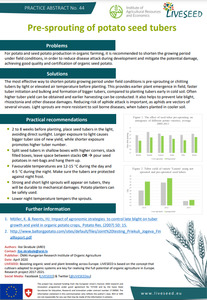{Tool} Pre-sprouting of potato seed tubers (Liveseed Practice Abstract). Creator(s): Skrabule, Ilze. Issuing Organisation(s): AREI - Institute of Agricultural Resources and Economics. Liveseed Practice Abstract, no. 44. (2020)
|
PDF
- English
(Pre-sprouting of potato seed tubers)
919kB | |
![[thumbnail of 2023-01-09 14_20_15-PowerPoint Presentation.png]](/37873/3.hassmallThumbnailVersion/2023-01-09%2014_20_15-PowerPoint%20Presentation.png)  Preview |
Image (PNG)
- Cover Image
- English
149kB |
Document available online at: https://www.liveseed.eu/wp-content/uploads/2020/04/PA44_Pre-sprouting-of-potato-seed-tubers.pdf
Summary in the original language of the document
Practical Recommendations
- 2 to 8 weeks before planting, place seed tubers in the light, avoiding direct sunlight. Longer exposure to light causes bigger tuber size of new yield, while shorter exposure promotes higher tuber number.
- Split seed tubers in shallow boxes with higher corners, stack filled boxes, leave space between stacks OR pour seed potatoes in net-bags and hang them up.
- Favourable temperatures are 12-15 °C during the day and 4-5 °C during the night. Make sure the tubers are protected against night frost.
- Strong and short light sprouts will appear on tubers, they will be durable to mechanical damages. Potato planters can be safely used.
- Lower night temperature tempers the sprouts.
| EPrint Type: | Practice tool |
|---|---|
| What problem does the tool address?: | For potato and seed potato production in organic farming, it is recommended to shorten the growing period under field conditions, in order to reduce disease attack during development and mitigate the potential damage, achieving good quality and certification of organic seed potato. |
| What solution does the tool offer?: | The most effective way to shorten potato growing period under field conditions is pre-sprouting or chitting tubers by light or elevated air temperature before planting. This provides earlier plant emergence in field, faster tuber initiation and bulking and formation of bigger tubers, compared to planting tubers early in cold soil. Often higher tuber yield can be obtained and earlier harvesting can be conducted. It also helps to prevent late blight, rhizoctonia and other disease damages. Reducing risk of aphide attack is important, as aphids are vectors of several viruses. Light sprouts are more resistant to soil borne diseases, when tubers planted in cooler soil. |
| Country: | Latvia |
| Type of Practice Tool: | Practice abstracts |
| Keywords: | seeds, seed production, potato, root crops |
| Agrovoc keywords: | Language Value URI English seeds http://aims.fao.org/aos/agrovoc/c_6946 English seed production http://aims.fao.org/aos/agrovoc/c_6937 English root crops http://aims.fao.org/aos/agrovoc/c_6641 |
| Subjects: | Crop husbandry > Breeding, genetics and propagation Crop husbandry > Crop health, quality, protection Crop husbandry > Production systems > Root crops |
| Research affiliation: | European Union > Horizon 2020 > Liveseed European Union > Horizon 2020 > Liveseed > Liveseed tools Latvia > Other Organizations Latvia European Union > Organic Farm Knowledge |
| Horizon Europe or H2020 Grant Agreement Number: | 727230 |
| Related Links: | https://organic-farmknowledge.org/tool/37873, https://www.arei.lv/en, https://orgprints.org/37873 |
| Project ID: | ofk |
| Deposited By: | Ortolani, Dr. Livia |
| ID Code: | 37873 |
| Deposited On: | 14 Apr 2020 07:11 |
| Last Modified: | 02 May 2024 10:32 |
| Document Language: | English |
| Status: | Published |
Repository Staff Only: item control page

 Download Statistics
Download Statistics Download Statistics
Download Statistics
